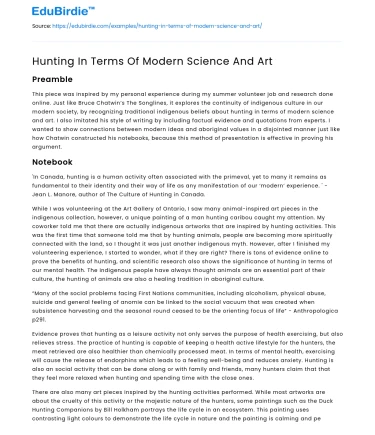Preamble
This piece was inspired by my personal experience during my summer volunteer job and research done online. Just like Bruce Chatwin’s The Songlines, it explores the continuity of indigenous culture in our modern society, by recognizing traditional indigenous beliefs about hunting in terms of modern science and art. I also imitated his style of writing by including factual evidence and quotations from experts. I wanted to show connections between modern ideas and aboriginal values in a disjointed manner just like how Chatwin constructed his notebooks, because this method of presentation is effective in proving his argument.
Notebook
'In Canada, hunting is a human activity often associated with the primeval, yet to many it remains as fundamental to their identity and their way of life as any manifestation of our ‘modern’ experience. ' - Jean L. Manore, author of The Culture of Hunting in Canada.
Save your time!
We can take care of your essay
- Proper editing and formatting
- Free revision, title page, and bibliography
- Flexible prices and money-back guarantee
While I was volunteering at the Art Gallery of Ontario, I saw many animal-inspired art pieces in the indigenous collection, however, a unique painting of a man hunting caribou caught my attention. My coworker told me that there are actually indigenous artworks that are inspired by hunting activities. This was the first time that someone told me that by hunting animals, people are becoming more spiritually connected with the land, so I thought it was just another indigenous myth. However, after I finished my volunteering experience, I started to wonder, what if they are right? There is tons of evidence online to prove the benefits of hunting, and scientific research also shows the significance of hunting in terms of our mental health. The indigenous people have always thought animals are an essential part of their culture, the hunting of animals are also a healing tradition in aboriginal culture.
“Many of the social problems facing First Nations communities, including alcoholism, physical abuse, suicide and general feeling of anomie can be linked to the social vacuum that was created when subsistence harvesting and the seasonal round ceased to be the orienting focus of life” - Anthropologica p291.
Evidence proves that hunting as a leisure activity not only serves the purpose of health exercising, but also relieves stress. The practice of hunting is capable of keeping a health active lifestyle for the hunters, the meat retrieved are also healthier than chemically processed meat. In terms of mental health, exercising will cause the release of endorphins which leads to a feeling well-being and reduces anxiety. Hunting is also an social activity that can be done along or with family and friends, many hunters claim that that they feel more relaxed when hunting and spending time with the close ones.
There are also many art pieces inspired by the hunting activities performed. While most artworks are about the cruelty of this activity or the majestic nature of the hunters, some paintings such as the Duck Hunting Companions by Bill Holkham portrays the life cycle in an ecosystem. This painting uses contrasting light colours to demonstrate the life cycle in nature and the painting is calming and peaceful instead of the common bloody image.
In addition, there are also other cultures such as Sikhism that believes in the spiritual healing power of hunting. It is believed that only meat retrieved from hunting are permitted and the courageous act of hunting will make the one creator heal their spirit.
Hunting has been the center of many controversies, but it can act as a positive way to heal others under specific legislations. The interaction between human and nature during the hunting process is what interested me the most. It is also evident that hunting can spiritually heal people by relieving stress or enhancing faith.






 Stuck on your essay?
Stuck on your essay?

